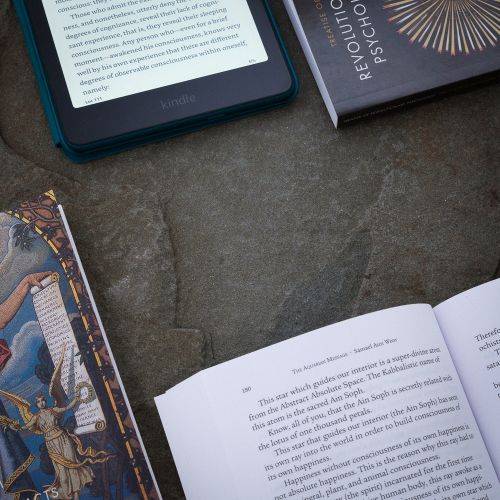1. Our spinal column has seven igneous roses.
2. With the sacred fire of the Shushumna channel these seven igneous roses enter into activity.
3. This sacred fire is engendered when the solar and lunar atoms of our two ganglionic cords come into contact.
4. In the East, these two sympathetic cords are known as Ida and Pingala.
5. Ida and Pingala function along the curved surface of our spinal medulla, where the Shushumna channel is located.
6. These two sympathetic cords are our two witnesses, our two olive branches, and the two candlesticks that are before the god of the earth.
7. These two cords emerge from the center of the sacrum, which is called the Triveni of the medulla oblongata.
8. When the solar and lunar atoms of these two cords come into contact in the sacrum, the sacred fire awakens, and the Triveni or Muladhara enters into activity. This is the church of the coccyx which has the power of opening the prostatic or fundamental chakra.
9. The vertebral column is known by the Hindus as Brahmadanda or the staff of Brahma. It is also symbolized by the bamboo reed with seven knots that the yogis from India carry.
10. The Shushumna channel together with the two sympathetic cords are symbolized by the bamboo reed with three knots, that the Trans-himalayan yogis use. They continuously reunite at Lake Manasarovar. This is why they are known as Tridandins1. This is what the Brahmanic thread2 of the three vital airs of pure Akasha symbolizes.
11. The right ganglionic cord corresponds to the right nasal cavity. The left ganglionic cord belongs to the left nasal cavity.
12. The right ganglionic cord is solar, positive. The left ganglionic cord is lunar, negative.
13. When the solar and lunar atoms of the Brahmanic cord come into contact in the center of the sacrum Triveni, then the Kundalini enters into activity. It then opens its way towards Brahmarandra, which is the frontal fontanel of a newborn, in order to shine brightly in the middlebrow, neck, and heart, in successive order.
14. The seat of Brahma is in the heart. The heart is the seat of Atman-Buddhi-Manas. The spiritual man resides in the heart.
15. The first serpent, that corresponds to the physical body, reaches only to Brahmarandra, in order to shine with splendor in the frontal chakra. This center has ninety-six rays.
16. The second serpent, that corresponds to the ethereal body, reaches only to the middlebrow.
17. However, the five other serpents must inevitably reach the heart.
18. The second rose of our spinal column opens the solar plexus. This center has ten rays: five active and five passive.
19. However, the sacred fire puts all of them into complete activity.
20. The brain and the heart totally shine with the fire of Kundalini.
21. The septenary activity of the sacred fire in the pineal gland is reflected in the aura of the heart. This is how the sacred fire places the seven cardiac centers into activity.
22. The third center enters into complete activity when the Kundalini lights the third igneous rose.
23. The chakra of the heart has twelve petals.
24. The fourth igneous rose opens our igneous wings and is intimately related with the sense of touch.
25. The fifth igneous rose opens our chakra of the thyroid, which is related with the esoteric ear.
26. The sixth igneous rose belongs to the thirty-second vertebra of our spinal column. This is the second highest chamber of the head, and it opens the frontal chakra that gives us clairvoyance.
27. This center has ninety-six rays and it shines in the middlebrow with the sacred fire.
28. The frontal chakra is the organ of vision in the psychic plane.
29. This organ resides in the pituitary gland, which has seven types of hormones.
30. The seventh igneous rose corresponds to the pineal gland.
31. The pituitary gland is only the instrument or the carrier of the light of the pineal gland.
32. In the woman, the pineal gland corresponds to the uterus and its peduncles with the fallopian tubes.
33. In the man, the pineal gland is found intimately related with the sexual glands.
34. We now explain to ourselves why this chakra cannot enter into activity in fornicators.
35. Any sexual decline is reflected in the pineal gland.
36. The entire majesty of God is expressed in the seventh igneous rose.
37. This seventh igneous rose is the crown of the saints, and it has one thousand petals of indescribable splendor.
38. Our brain has seven cavities, and our heart also has seven centers.
39. These seven cavities of our brain correspond to the seven scales of the divine harmonies and are occupied by pure Akasha...
40. The psychic-mental man resides in the head with his seven gates, and Atman-Buddhi-Manas (the heavenly man) resides in the heart.
41. We must unite the mind with the heart by means of the fire.
42. The chalice and the heart must march in complete equilibrium. This is possible only by uniting the head and the heart by means of the fire.
43. The brain’s circumvolutions have been formed by the argentine armor of the mental body.
44. The third ventricle of the brain is filled with light and this light becomes splendorous with the sacred fire of the Kundalini.
45. The sixth cavity belongs to the pineal gland.
46. The pineal gland or crown center is a rounded body of six to eight millimetres in length. It possesses a reddish-grey, obscure color and is connected with the posterior part of the third ventricle of the brain.
47. It has two very fine and beautiful medullar fibers in its base, that diversely direct themselves towards the optic thalamus.
48. The pituitary body is found connected to the pineal gland by a very fine capillary channel, which disappears in the corpse.
49. The pineal gland is surrounded by a very fine and tiny sand.
50. This tiny sand is the “Acerbulus Cerebri,” the concreteness of the mental body and the efficient instrument of the mind.
51. The seven capital chakras that govern the seven plexes reside in the head.
52. When the mental body has been totally Christified by the fourth serpent, it converts itself into an efficient instrument for the Innermost.
53. The real Being utilizes the mind as an element of regulation and control for the seven astral plexes.
54. The mind controls its plexes by means of the seven capital chakras of the brain.
55. The solar plexus is our brain of emotions and when entering into activity it awakens the hepatic and splenic plexes.
56. The heart represents our divine triad3. The hepatic and splenic plexes represent our inferior quaternary4. Esoterically, the solar plexus is the brain of the stomach in which we place Saturn, which is the sun of our organism.
57. The spiritual devotees of all schools have studied the astral chakras, but they have never studied the seven candlesticks of the mental body that glow in the fire of the arhat.
58. Our chakras are septuple in their constitution, as well as in our sacred serpent and our Brahmanic cord.
59. The seven igneous roses of our spinal medulla are also septuple in their internal constitution.

60. Our brain has seven cavities and our heart also has seven divine centers.
61. The sacred fire enters into activity when the solar and lunar atoms of the Brahmanic cord come into contact in the Triveni. This contact is possible only by intensely practicing sexual magic with our spouse, or by means of the sacrifice of a complete and definitive sexual abstention.
62. The most powerful mantras that are known in the entire infinite for the awakening of the sacred fire are: Kandil Bandil Rrrrrr.
63. These mantras are vocalized in a singing form as follows: KAN (resounding voice) DIL (decreasing voice) BAN (resounding voice) DIL (decreasing voice) Rrrrrrrr (rolled). The letter ‘R’ is pronounced with a high sound and rolled, imitating the sound of the rattles of a rattlesnake.
64. The first igneous rose of our spinal column corresponds to the reproductive and respiratory organs of the race.
65. The second igneous rose corresponds to the sense of taste. The third igneous rose corresponds to the heart. The fourth igneous rose corresponds to the wings. The fifth igneous rose corresponds to the ear. The sixth igneous rose corresponds to the sense of sight. The seventh igneous rose corresponds to the Diamond Eye, Eye of Brahma, crown chakra or center of polyvoyance that permits us to see in all the planes of consciousness.
66. All of our senses are intimately related with the tattvas and with the distinct spheres or planes of cosmic consciousness that express themselves through the seven igneous roses of our spinal column.
67. The awakening of the seven igneous roses gives us access to the superlative planes of cosmic consciousness.
68. This ascension is performed in a spiral through the seven degrees of the power of the fire.
69. The sacred fire opens the avenues of the truth.
70. The sense of touch belongs to the fourth igneous rose, to the eternal wings that permit us to soar from sphere to sphere in the planes of superlative consciousness, where only the happiness of the Being reigns.







